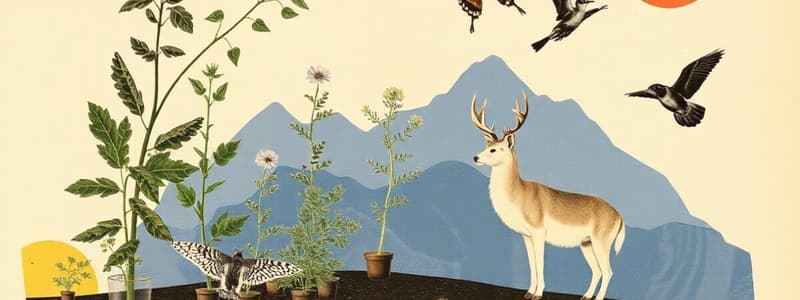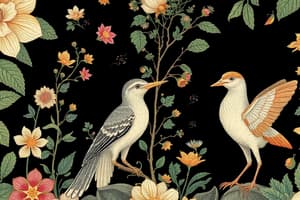Podcast
Questions and Answers
The stages of development that occur during an organism's life do not make up its life cycle.
The stages of development that occur during an organism's life do not make up its life cycle.
False (B)
All living things follow a pattern of: birth, growth, maturation, and death.
All living things follow a pattern of: birth, growth, maturation, and death.
False (B)
Before a baby is born, it usually develops inside the mother's body for approximately nine months.
Before a baby is born, it usually develops inside the mother's body for approximately nine months.
True (A)
A toddler is defined as a newly born baby.
A toddler is defined as a newly born baby.
Infants typically crawl or walk and start eating solid food.
Infants typically crawl or walk and start eating solid food.
The life stage of childhood will end at around the age of 20.
The life stage of childhood will end at around the age of 20.
During childhood, baby teeth are replaced by a second set of baby teeth.
During childhood, baby teeth are replaced by a second set of baby teeth.
Puberty is a period of significant physical changes that happens in adolescence, during which the body becomes incapable of reproduction.
Puberty is a period of significant physical changes that happens in adolescence, during which the body becomes incapable of reproduction.
Adolescence typically begins slightly later for boys compared to girls.
Adolescence typically begins slightly later for boys compared to girls.
Adulthood occurs after adolescence and is characterized by mental stability.
Adulthood occurs after adolescence and is characterized by mental stability.
Flashcards
What is a life cycle?
What is a life cycle?
The series of changes an organism goes through during its life.
What is infancy?
What is infancy?
The stage of growth from birth to about age one or two.
What is childhood?
What is childhood?
The stage of life following infancy, lasting until about age 12.
What is adolescence?
What is adolescence?
Signup and view all the flashcards
What is adulthood?
What is adulthood?
Signup and view all the flashcards
How humans grow?
How humans grow?
Signup and view all the flashcards
Who is an adult?
Who is an adult?
Signup and view all the flashcards
What are infants?
What are infants?
Signup and view all the flashcards
What is puberty?
What is puberty?
Signup and view all the flashcards
Study Notes
- The work plan includes routines, review, activity, discussion, IXL activity, and wrap-up.
- Plants and animals differ from one another.
Science Trivia
- The oldest known fossil is made up of blue-green algae from South Africa at 3.2 billion years old.
- The oldest living thing known on Earth is a bristlecone pine in California that is about 4600 years old.
- The world's tallest grass is bamboo; some species reach heights of up to 39 meters.
- The top speed of a cheetah is 120 km/h.
- A cross between a tiger and a lion is called a liger.
Life Cycle
- The stages of growth and change make up an organism's life cycle.
- All living things follow a pattern of birth, growth, reproduction, and death.
Stages in Human Life Cycle
- All humans go through a series of changes as they grow
- Before a baby is born, it develops inside the mother's body for about nine months.
Infants
- Newly born babies are called Infants.
- Infancy is the stage of growth from birth to about age one or two.
- Infants grow and develop very quickly.
- By the end of infancy, many skills have been learnt.
- Infants learn to crawl or walk, eat solid food, and begin speaking.
Childhood
- Childhood is the stage that follows infancy and lasts until about age 12.
- During childhood, adult teeth replace the first set of baby teeth.
- Bones and muscles develop, and the body grows taller.
- Children learn and practice many skills.
- Children can understand and discuss their feelings.
Adolescence
- Adolescence is the stage that lasts from about age 12 to age 18.
- Puberty happens during adolescence.
- Pubery is when the body becomes capable of reproduction.
- For girls, puberty typically begins at 12 or 13, while for boys, it begins about two years later.
- Most young adolescents experience a growth spurt or a period of rapid growth.
- Along with physical changes, adolescence may also bring mental and social changes.
Adulthood
- Adulthood lasts from about age 18 to 70 years and beyond.
- Young parents, grandparents, and teachers are adults.
- Adulthood represents the mature stage of human development.
- As an adult, you will need to provide food for yourself.
- Reading books and learning new skills help to keep your mind active throughout your adulthood.
Studying That Suits You
Use AI to generate personalized quizzes and flashcards to suit your learning preferences.


